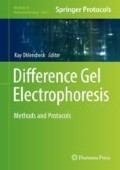Abstract
Comparative tissue proteomics aims to analyze alterations of the proteome in response to a stimulus. Two-dimensional difference gel electrophoresis (2D-DIGE) is a modified and advanced form of 2D gel electrophoresis. DIGE is a powerful biochemical method that compares two or three protein samples on the same analytical gel, and can be used to establish differentially expressed protein levels between healthy normal and diseased pathological tissue sample groups. Minimal DIGE labeling can be used via a 2-dye system with Cy3 and Cy5 or a 3-dye system with Cy2, Cy3, and Cy5 to fluorescently label samples with CyDye flours pre-electrophoresis. DIGE circumvents gel-to-gel variability by multiplexing samples to a single gel and through the use of a pooled internal standard for normalization. This form of quantitative high-resolution proteomics facilitates the comparative analysis and evaluation of tissue protein compositions. Comparing tissue groups under different conditions is crucially important for advancing the biomedical field by characterization of cellular processes, understanding pathophysiological development and tissue biomarker discovery. This chapter discusses 2D-DIGE as a comparative tissue proteomic technique and describes in detail the experimental steps required for comparative proteomic analysis employing both options of 2-dye and 3-dye DIGE minimal labeling.
Access this chapter
Tax calculation will be finalised at checkout
Purchases are for personal use only
References
Meissner F, Mann M (2014) Quantitative shotgun proteomics: considerations for a high-quality workflow in immunology. Nat Immunol 15(2):112–117. doi:10.1038/ni.2781
Wilhelm M, Schlegl J, Hahne H et al (2014) Mass-spectrometry-based draft of the human proteome. Nature 509(7502):582–587. doi:10.1038/nature13319
Dubowitz V, Sewry CA, Oldfors A (2013) Muscle biopsy: a practical approach, 4th edn. Saunders Elsevier, Philadelphia
Holland A, Ohlendieck K (2015) Comparative profiling of sperm proteome. Proteomics 15(4):632–648. doi:10.1002/pmic.201400032
Jockusch H, Holland A, Staunton L, Schmitt-John T, Heimann P, Dowling P, Ohlendieck K (2014) Pathoproteomics of testicular tissue deficient in the GARP component VPS54: the wobbler mouse model of globozoospermia. Proteomics 14(7–8):839–852. doi:10.1002/pmic.201300189
Holland A, Ohlendieck K (2014) Proteomic identification of muscle-associated biomarkers of amyotrophic lateral sclerosis using the wobbler mouse model of primary motor neuropathy. J Integr OMICS 4(2):57–68. doi:10.5584/jiomics.v4i2.171
Holland A, Ohlendieck K (2014) Comparative proteomics for studying muscular dystrophy: intrinsic biological and analytical issues associated with the systemic utilization of tissue specimens. J Proteomics Bioinform S10:002. doi:10.4172/jbs.S10-002
Dowling P, Holland A, Ohlendieck K (2014) Mass spectrometry-based identification of muscle-associated and muscle derived proteomic biomarkers of dystrophinopathies. J Neuromuscul Dis 1(1):15–40. doi:10.3233/JND-140011
Rabilloud T, Lelong C (2011) Two-dimensional gel electrophoresis in proteomics: a tutorial. J Proteome 74(10):1829–18241. doi:10.1016/j.jprot.2011.05.040
Murphy S, Dowling P, Ohlendieck K (2016) Comparative skeletal muscle proteomics using two-dimensional gel electrophoresis. Proteomes 4(3):27. doi:10.3390/proteomes4030027
O’Farrell PH (1975) High resolution two-dimensional electrophoresis of proteins. J Biol Chem 250(10):4007–4021
Rible H (1973) Historical and theoretical aspects of isoelectric focusing. Ann N Y Acad Sci 209:11–22
Unlu M, Morgan ME, Minden JS (1997) Difference gel electrophoresis: a single gel method for detecting changes in protein extracts. Electrophoresis 18(11):2071–2077. doi:10.1002/elps.1150181133
Arentz G, Weiland F, Oehler MK, Hoffmann P (2015) State of the art of 2D DIGE. Proteomics Clin Appl 9(3–4):277–288. doi:10.1002/prca.201400119
Minden JS (2012) DIGE: past and future. Methods Mol Biol 854:3–8. doi:10.1007/978-1-61779-573-2_1
Shaw J, Rowlinson R, Nickson J, Stone T, Sweet A, Williams K, Tongue R (2003) Evaluation of saturation labelling two-dimensional difference gel electrophoresis fluorescent dyes. Proteomics 3(7):1181–1195. doi:10.1002/pmic.200300439
Tonge R, Shaw J, Middleton B, Rowlingson R, Rayner S, Young J, Pognan F, Hawkins E, Currie I, Davison M (2001) Validation and development of fluorescence two-dimensional differential gel electrophoresis proteomics technology. Proteomics 1((3)):377–396. doi: 10.1002/1615–9861(200103)1:3,377::AID-PROT377>3.0.CO;2–6
Viswanathan S, Unlu M, Minden JS (2006) Two-dimensional difference gel electrophoresis. Nat Protoc 1(3):1351–1358. doi:10.1038/nprot.2006.234
Minden J (2007) Comparative proteomics and difference gel electrophoresis. BioTechniques 43(6):739–745
Karp NA, Lilley KS (2005) Maximising sensitivity for detecting changes in protein expression: experimental design using minimal CyDyes. Proteomics 5(12):3105–3115. doi:10.1002/pmic.200500083
Karp NA, McCormick PS, Russell MR, Lilley KS (2007) Experimental and statistical consideration to avoid false conclusions in proteomics studies using differential in-gel electrophoresis. Mol Cell Proteomics 6(8):1354–1364. doi:10.1074/mcp.M600274-MCP200
Holland A, Schmitt-John T, Dowling P, Meleady P, Henry M, Clynes M, Ohlendieck K (2014) Intricate effects of primary motor neuropathy on contractile proteins and metabolic muscle enzymes as revealed by label-free mass spectrometry. Biosci Rep 34(4):331–343. doi:10.1042/BSR20140029
Beckett P (2012) The basics of 2D DIGE. Difference gel electrophoresis (DIGE): methods and protocols. Methods Mol Biol 854:9–18. doi:10.1007/978-1-61779-573-2_2
Acknowledgments
Research in the author’s laboratory has been supported by project grants from the Irish Higher Education Authority (BioAT) and Muscular Dystrophy Ireland.
Author information
Authors and Affiliations
Corresponding author
Editor information
Editors and Affiliations
Rights and permissions
Copyright information
© 2018 Springer Science+Business Media LLC
About this protocol
Cite this protocol
Holland, A. (2018). Comparative Testis Tissue Proteomics Using 2-Dye Versus 3-Dye DIGE Analysis. In: Ohlendieck, K. (eds) Difference Gel Electrophoresis. Methods in Molecular Biology, vol 1664. Humana Press, New York, NY. https://doi.org/10.1007/978-1-4939-7268-5_15
Download citation
DOI: https://doi.org/10.1007/978-1-4939-7268-5_15
Published:
Publisher Name: Humana Press, New York, NY
Print ISBN: 978-1-4939-7267-8
Online ISBN: 978-1-4939-7268-5
eBook Packages: Springer Protocols

